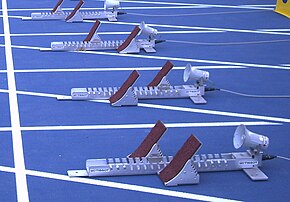Portal:Sport of athletics/Selected article/3

Starting blocks are a device used in the sport of track and field by sprint athletes to brace their feet against at the start of a race so they do not slip as they stride forward at the sound of the starter's pistol. The blocks also enable the sprinters to adopt a more efficient starting posture and isometrically preload their muscles in an enhanced manner. This allows them to start more powerfully and increases their overall sprint speed capability.
For most levels of competition, including the whole of high-level international competition, starting blocks are mandatory equipment for the start of sprint races. Their invention is credited to Australian Charlie Booth and his father in 1929. Prior to this, runners would dig holes in the dirt track. Trowels were provided at the start of races. This was not the most consistent or stable system. It also was destructive to the track surface with the holes having to be filled for subsequent runners. When George Simpson became the first person to run 9.4 seconds for the 100-yard dash in 1930, his record was disallowed because he used starting blocks.
Modern blocks used for world records now must have sensors that detect the pressure from the athlete and can be used to time their reaction to the starting gun. Athletes who react faster than one-tenth of a second can be charged with a false start and the race recalled. Many also carry electronic speakers so the sound of the gun arrives at the ears of the athletes at exactly the same time. Some races for hearing-impaired athletes have also used starting light systems, similar to motorsport's Christmas Tree. (Full article...)
| More selected articles |